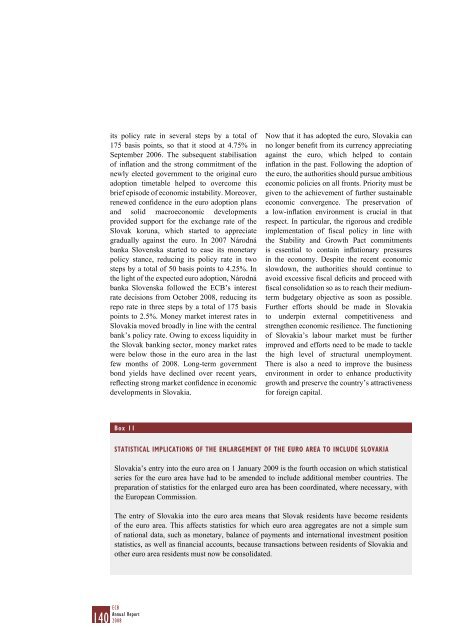ANNUAL REPORT 2008 - Polymer Bank Notes of the World
ANNUAL REPORT 2008 - Polymer Bank Notes of the World
ANNUAL REPORT 2008 - Polymer Bank Notes of the World
You also want an ePaper? Increase the reach of your titles
YUMPU automatically turns print PDFs into web optimized ePapers that Google loves.
its policy rate in several steps by a total <strong>of</strong>175 basis points, so that it stood at 4.75% inSeptember 2006. The subsequent stabilisation<strong>of</strong> inflation and <strong>the</strong> strong commitment <strong>of</strong> <strong>the</strong>newly elected government to <strong>the</strong> original euroadoption timetable helped to overcome thisbrief episode <strong>of</strong> economic instability. Moreover,renewed confidence in <strong>the</strong> euro adoption plansand solid macroeconomic developmentsprovided support for <strong>the</strong> exchange rate <strong>of</strong> <strong>the</strong>Slovak koruna, which started to appreciategradually against <strong>the</strong> euro. In 2007 Národnábanka Slovenska started to ease its monetarypolicy stance, reducing its policy rate in twosteps by a total <strong>of</strong> 50 basis points to 4.25%. In<strong>the</strong> light <strong>of</strong> <strong>the</strong> expected euro adoption, Národnábanka Slovenska followed <strong>the</strong> ECB’s interestrate decisions from October <strong>2008</strong>, reducing itsrepo rate in three steps by a total <strong>of</strong> 175 basispoints to 2.5%. Money market interest rates inSlovakia moved broadly in line with <strong>the</strong> centralbank’s policy rate. Owing to excess liquidity in<strong>the</strong> Slovak banking sector, money market rateswere below those in <strong>the</strong> euro area in <strong>the</strong> lastfew months <strong>of</strong> <strong>2008</strong>. Long-term governmentbond yields have declined over recent years,reflecting strong market confidence in economicdevelopments in Slovakia.Now that it has adopted <strong>the</strong> euro, Slovakia canno longer benefit from its currency appreciatingagainst <strong>the</strong> euro, which helped to containinflation in <strong>the</strong> past. Following <strong>the</strong> adoption <strong>of</strong><strong>the</strong> euro, <strong>the</strong> authorities should pursue ambitiouseconomic policies on all fronts. Priority must begiven to <strong>the</strong> achievement <strong>of</strong> fur<strong>the</strong>r sustainableeconomic convergence. The preservation <strong>of</strong>a low-inflation environment is crucial in thatrespect. In particular, <strong>the</strong> rigorous and credibleimplementation <strong>of</strong> fiscal policy in line with<strong>the</strong> Stability and Growth Pact commitmentsis essential to contain inflationary pressuresin <strong>the</strong> economy. Despite <strong>the</strong> recent economicslowdown, <strong>the</strong> authorities should continue toavoid excessive fiscal deficits and proceed withfiscal consolidation so as to reach <strong>the</strong>ir mediumtermbudgetary objective as soon as possible.Fur<strong>the</strong>r efforts should be made in Slovakiato underpin external competitiveness andstreng<strong>the</strong>n economic resilience. The functioning<strong>of</strong> Slovakia’s labour market must be fur<strong>the</strong>rimproved and efforts need to be made to tackle<strong>the</strong> high level <strong>of</strong> structural unemployment.There is also a need to improve <strong>the</strong> businessenvironment in order to enhance productivitygrowth and preserve <strong>the</strong> country’s attractivenessfor foreign capital.Box 11STATISTICAL IMPLICATIONS OF THE ENLARGEMENT OF THE EURO AREA TO INCLUDE SLOVAKIASlovakia’s entry into <strong>the</strong> euro area on 1 January 2009 is <strong>the</strong> fourth occasion on which statisticalseries for <strong>the</strong> euro area have had to be amended to include additional member countries. Thepreparation <strong>of</strong> statistics for <strong>the</strong> enlarged euro area has been coordinated, where necessary, with<strong>the</strong> European Commission.The entry <strong>of</strong> Slovakia into <strong>the</strong> euro area means that Slovak residents have become residents<strong>of</strong> <strong>the</strong> euro area. This affects statistics for which euro area aggregates are not a simple sum<strong>of</strong> national data, such as monetary, balance <strong>of</strong> payments and international investment positionstatistics, as well as financial accounts, because transactions between residents <strong>of</strong> Slovakia ando<strong>the</strong>r euro area residents must now be consolidated.140 ECBAnnual Report<strong>2008</strong>




![KNOW YOUR NEW GIBRALTAR BANKNOTES - [Home] bThe/b](https://img.yumpu.com/50890985/1/184x260/know-your-new-gibraltar-banknotes-home-bthe-b.jpg?quality=85)
![PAPUA NEW GUINEA - [Home] - Polymer Bank Notes of the World](https://img.yumpu.com/49758743/1/190x143/papua-new-guinea-home-polymer-bank-notes-of-the-world.jpg?quality=85)










